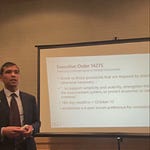This is a transcript of a live video.
Welcome to a live GovCon Intelligence video. We’re going to be going over a filing at the Supreme Court about the 8(a) program, as well as a filing in state or district court in Louisiana about the 8(a) program’s race-based presumption. There’s also been a bill introduced in the Senate about suspending 8(a) sole source awards. During the SBA audit, Secretary Hegseth of the Department of War gave a speech about acquisition transformation, and GAO has reopened. So there have been a couple of cases about small businesses at the VA and involving NAICS codes coming out of the GAO. Also, go over a few questions that we’ve received through the app and by email through the GovCon Intelligence Newsletter.
As a reminder, you can always comment on this post or send me an email, or fill out the contact me form to send questions for the next edition of our Q&A.
A Supreme Court petition on the 8(a) program
Well, I’ll get started with two filings in court about the SBA’s 8(a) program. You might remember back in 2023, SBA changed the way that companies can qualify for the 8(a) program. Prior to 2023, companies could go and check a box related to their race or ethnicity, and automatically qualify as socially disadvantaged for the 8(a) program. But in 2023, a court decided in the Ultima decision that the race-based presumption violated the Constitution. So starting in 2023, SBA stopped using the race-based presumption and required all existing 8(a) firms to submit narratives to establish eligibility without using that presumption. And every firm that’s applied to the 8(a) program since that Ultima decision has had to go through that narrative process as well.
But even though SBA stopped using the race-based presumption, conservative action groups have now filed in two different forums to get the presumption removed from SBA’s regulations. One of the cases seeks Supreme Court review. The Pacific Legal Foundation has filed for cert at the Supreme Court to bring back a challenge from the Fourth Circuit to the presumption. That foundation wants SBA to remove the presumption entirely from the 8(a) regulations and concede the unconstitutionality of the presumption. A separate filing in a Louisiana lower court from the Center for Individual Rights says that the presumption is used not just for SBA programs like the 8(a) program, but also in programs at NASA, EPA, and DHS. That Center for Individual Rights lawsuit asked the court to declare SBA’s presumption unconstitutional.
These cases are asking the court in Louisiana and the Supreme Court to invalidate a presumption that isn’t even being used by SBA anymore. SBA stopped using them in 2023. So this is really more performative than it would be substantive for the 8(a) program. The second case is interesting, the Louisiana lower court one, because that brings in other agencies, programs like NASA, EPA, and DHS. It’s not really clear whether those agencies are applying the presumption in those cases as well. Recently, the DOT Department of Transportation stopped using the presumption for the Disadvantaged Business Enterprise program, the DBE program, for state-level construction contracting. So it’s not really clear how many agencies are still applying the presumption after SBA stopped using it a couple of years ago, after the Ultima decision.
These cases are being filed. I think it does draw attention to this issue of the prior use of the presumption and certainly prevents, if the cases were to be successful, the presumption from ever coming back. That’s probably a foregone conclusion after the Supreme Court’s affirmative action decisions earlier in 2023. So we’ll certainly watch whether the Supreme Court takes the case brought by the Pacific Legal Foundation. Probably unlikely, given the way that case was decided by the Fourth Circuit. But who knows? The Supreme Court may be looking to bring back an affirmative action-type case and rule on that. So we’ll watch and see whether the Supreme Court takes on that case.
Senate bill to suspend 8(a) sole-source awards
More developments on the 8(a) program. Recently, Senator Joni Ernst, who’s the chair of the Senate Small Business Committee, introduced a bill in the Senate. It is, let’s see, I think it was S. 3137 [actually S. 3173]. Let me make sure. Here it is. Yes. 3173. It’s called the Stop 8(a) Contracting Fraud Act. And that bill from Senator Ernst, which right now has just been introduced in the Senate, would create a moratorium. It says the SBA may not award sole source contracts under Section 8(a) during the period that the bill is passed, is in place, and ending when the SBA completes an audit of the 8(a) program. So this would prevent SBA from awarding new 8(a) sole source contracts during the term of that audit.
Now it’s fairly clear from the press release that Senator Ernst sent out at the same time as introducing this bill that the impetus for this bill was the YouTube video about ATI Government Solutions, alleging that ATI violated SBA’s limitations on subcontracting. The bill was accompanied by a couple of letters from Senator Ernst, one to the SBA Administrator and another to the SBA Office of Inspector General. The SBA Administrator letter asked for documents from the SBA related to the 8(a) program and compliance and limitation on subcontracting, and the letter to the SBA Acting Inspector General asked for a briefing as to the ATI case and other situations where SBA firms might have violated the limitations on subcontracting.
Certainly brings attention to this issue of the limitations on subcontracting and whether 8(a) firms are complying with that. It’s not clear, as I wrote in an article a few weeks ago, it’s not clear that ATI Government Solutions violated the limitations of subcontracting. There are important exceptions to the limitations of subcontracting, including the similarly situated entity rule that would allow a company to subcontract more than 50% and still be compliant with the limitations on subcontracting rule. So we’ll have to see what happens with the ATI case.
The bigger issue is going to be for 8(a) firms that have contracts now or have had contracts in the recent past, because SBA and other agencies may be coming to get documentation on those contracts to determine whether the firms complied with the limitations of subcontracting. We’ve already seen from the Department of the Treasury that they are initiating an audit of their $9 billion of preference contracts in their portfolio. So 8(a) firms certainly have to be on alert for audit requests, enforcement actions related to limitations on subcontracting.
Acquisition Transformation at DoW
A couple more things I want to go over. First, the speech from Secretary Hegseth on November 10th [actually November 7] on acquisition transformation. The really wide-ranging speech was about 70 minutes. It was followed by a number of memos and a guide for acquisition transformation within the Department of War. Probably the biggest part of that is the introduction to this concept of PAEs, Portfolio Acquisition Executives. So these would be accountable officials that are in charge of a full acquisition portfolio and they’d be able to trade off between different acquisition priorities and make cost value trade offs and ultimately it sounds like contracting officers and program managers would report up to that PAE structure, that accountable official.
One of the big innovations on this is allowing the PAEs to stay longer in their positions than DoD has had in the past for similar portfolio managers. The guidance said that the PAEs would have four-year terms, so they have longer terms than the officials have had in the past. A lot of this strategy talks about having acquisition move at the pace of war, at the speed of war, rather than the speed of paperwork. So Department of War certainly wants to move faster, and they say that they want to get new entrants into the acquisition base. So that’s good for small businesses. It’s good for commercial sellers. The acquisition transformation wants to purchase more commercially, and it wants more competition. So if you’re a competitive small business, perhaps you sold outside of DOW and now you want to get into that space. This is an opportunity under this acquisition transformation to sell your wares to the Department of Defense, Department of War. So we’ll watch on acquisition transformation to see what actual policy changes are made. You can probably expect to see more about this under the DFARS when they get around to overhauling that.
GAO rules on small business: NAICS and LOS
And then at the same time, the GAO reopened. The GAO reopened last Thursday, and right away, there was, very exciting for me, a small business case. The very first case that the GAO published after the shutdown was about a small business requirement for NAICS codes. And there’s even been another one since then. So we’re starting to see more GAO protests coming out, and a good number of them deal with the small business rules that apply in 13 CFR and FAR part 19.
Fidelity Contract Flooring: missing NAICS in SAM
So the first case was about NAICS codes and is called Fidelity Contract Flooring. The contractor, the protester in that case, argued that the awardee of a VA contract should not have gotten the award because that company, the awardee, did not have the NAICS code for the contract in its SAM profile. So, when you sign up for SAM, you identify a number of NAICS codes that your company participates in, industries, and this company, VA-TRAK was the name of the awardee, did not have the specific NAICS code for the contract in its SAM list. It was 326199, All Other Plastics Product Manufacturing, did not have that in its NAICS codes list. So the protesters said they can’t be qualified as a small business because the small business rules say you have to be small for that NAICS code.
GAO denied the protest. GAO said that there have been many cases about this issue, at least two other cases where GAO has found that you do not have to have the NAICS code listed on your SAM profile in order to win an award as a small business. So GAO decided this issue in the past, and it said, look, we... We’ve said, yes, you have to be a small business, but that does not require that you have this NAICS code in your SAM profile in order to win the award as a small business.
It’s an interesting case because there had been a similar case out of the Court of Federal Claims about NAICS codes, and the other case, which is the Ekagra Partners, actually went the opposite direction. In Ekagra, the court said there was a requirement that the firm have NAICS code listed on SAM profile in order to qualify as small and that this was slightly different the facts were a little different the language was different in the RFP and involved a subcontractor instead of a prime contractor I think you can meld these cases together by saying in one case the judge found that the solicitation itself required the NAICS codes, whereas in the GAO case, the GAO said the solicitation did not require the NAICS codes. The language doesn’t really suggest one way or the other. So if you bring a case about NAICS codes, you’d have to look closely at whether you’re bringing a GAO or Court of Federal Claims because the precedent of those two different forums is different depending on what the solicitation actually says.
Another interesting aspect of Fidelity Contract Flooring was that the protester eventually brought up an issue about the non-manufacturer rule. That’s the SBA rule that says that to provide a manufactured product, remember this was a manufacturing code, you have to provide the product of a small business or provide your own product. And then if you’re providing the product of another small business, there are a number of requirements to do so, and one of those is that you normally sell the type of item being supplied. The GAO ultimately did not rule on that. I found it interesting because that argument is very rarely made. I don’t think I’ve seen very many cases at all about whether the awardee of a manufacturing contract normally sells the type of item being supplied. It’s not clear what facts SBA or GAO would look at to determine whether that company normally sells the type of item being supplied.
Ultimately, GAO found that argument to be untimely, so it didn’t get to the issue of whether the company normally sells the type of item being supplied. It would be fascinating to see what actually happens in that case, what sort of facts a company would show to say it normally sells that type. The idea behind that rule is, first of all, it’s read out of the statute, it’s an interpretation of the statute, but also it prevents a company that wants to get the contract but is not qualified from using another company as a pass-through just by maybe finding a brand new company or finding a company in a completely different field and putting them in the middle as the pass-through for a manufactured product contract.
Here, GAO dismissed that allegation as untimely and didn’t get to that issue. If GAO had tried to take that up, I probably think that that would be a size protest issue rather than a GAO protest issue. Non-manufacturer rule is usually an issue of size rather than something that GAO would take up in a bid protest.
AAA General Contractors: VA Limit on Subcontracting
The second case that GAO decided was about a VA-specific requirement. This was the AAA General Contractors or AAA General Contractors case that just came out yesterday. In this case, AAA General Contractors was rejected by the VA because the company failed to submit a certification that it would comply with the limitations on subcontracting. We’ve already talked about the limitations on subcontracting with respect to the 8(a) program. This is usually referred to as the 50% rule and basically says that you can’t subcontract more than a specific amount to contractors that are not similarly situated. That has a whole other meaning. You can go to my article to learn more about what similarly situated means. But essentially, it tells the prime contractor you can’t pass through some segment of this work. The percentage varies for supply contracts and services contracts. It’s 50% with construction contracts; it can be 35% or 25%, depending on whether it’s a specialty.
The VA has a special requirement. It was passed by Congress in 2019 [actually introduced in 2019 but passed in 2020] that requires the VA to obtain certifications of subcontracting compliance when the VA awards set aside to veteran-owned small businesses. So this is a requirement that applies to VA contracts that does not apply to contracts outside of the VA, or at least it doesn’t apply as a matter of law. Agencies might still require certification, but it’s not something that’s been passed by Congress in law. But this 2019 statute [actually 2020] specifically says the VA has to obtain these certifications.
Will AAA General Contractors did not submit the certification with its bid to the VA for two-phase design-build services, and the VA rejected the bid. The protester, AAA, came back and said it was clear in the solicitation that we had to submit a certification. And furthermore, this is an immaterial certification. It’s not a material requirement. It should have been waived as a minor informality. GAO rejected that protest, denied AAA’s arguments. It said, first of all, this is a legal requirement. It’s clear in the VA acquisition regulation that this is a requirement. It was also clear in the solicitation. It’s straightforward in the solicitation that you submit this certification. And also, this is a material proposal submission requirement. And if you do not submit that certification, your proposal can be found ineligible for award. So there was no basis to question the VA’s rejection of AAA’s proposal.
Good learning point for VA contractors that you do have this extra responsibility for VA contracts. You might not on non-VA contracts need to submit that certification with your bid that you will comply with the limitations on subcontractors. That’s a legal requirement passed by Congress in 2019, which found its way into the VA acquisition regulations and furthermore into solicitations. Very exciting time to be reading these bid protests as they come out after the shutdown. We’ll probably see more small business cases coming out of the VA [GAO, actually] shortly. That’s my case update.
Q&A about SDBs, eSRS, and Treasury
I did have a couple of questions come in that I’ll address now.
More SDB dollars mean more veteran-owned contracts
The article that I put out about the false choice between veteran-owned and disadvantaged discussed how veteran-owned companies are actually predominantly registered as small disadvantaged businesses. The data that I found was that two-thirds of veteran-owned small businesses are registered in SAM as disadvantaged. Why is that? Primarily, it’s probably because of disability. Disadvantage means more than race. It means more than gender. SBA lists other reasons, and these reasons can include disability. It can include isolation from a mainstream environment. That might be another reason for veterans to register as disadvantaged. But the main outcome is that two-thirds of veteran-owned small businesses are registered in SAM as SDBs, as small disadvantaged businesses.
I did make the point in that article that SDB does not stand for socially disadvantaged business. It stands for small disadvantaged business. The reason is you also need economic disadvantage in order to qualify as SDB. It’s not just the social disadvantage part. But whatever it is that helps SDB, small disadvantaged business, it seems also to help veteran-owned businesses. I went back and tracked that when the government raised the SDB goal during the last administration, that increased contracting with service-disabled veteran-owned businesses. And actually increased contracting with service-disabled veteran-owned businesses even more than it increased contracting with small disadvantaged businesses. So it would actually help service-disabled veteran-owned businesses more than SDBs.
I did get a comment on that saying that the executive orders that impact federal acquisition seem to telegraph this trend of trying to pit the programs against each other. That’s one thing I suggested in the article. And that may be something that’s happening on the outside as well, with government consultants saying this with respect to the women-owned small business program. I said in the article, this is the rising tide lifts all boats. What’s good for one program is probably good for all the other programs as well. When the overall small business number goes up, then you see the spending with all of the social economic programs increase.
So when you saw SDB go up. That affected all small businesses. We got a record 28.7% in 2024 with small businesses. And that increased spending with service-disabled, veteran-owned, HUBZone, women-owned, all of the programs across the board. So it’s not just one program versus the other. It’s probably better to grow the entire pie. And that seems to be the effort that might be ongoing with this acquisition transformation strategy from the Department of War to try to bring in new entrants, try to bring in more small businesses. But what’s good for one of them is good for all of them.
eSRS transition to SAM.gov
I also got a comment on chat in Substack. You can actually chat with me on Substack. That eSRS, the Electronic Subcontracting Reporting System, is being decommissioned on November 24th, just next week. That’s an announcement on SAM.gov. You can go to SAM.gov/eSRS for more information about the decommissioning of eSRS. So this is part of a long-term strategy by the Integrated Acquisition Environment, IAE, to fold all of these separate systems into SAM.gov. So you’ve seen that happen with CPARS, you’ve seen that happen with FSRS. You might remember back to the days where there was ORCA. That’s all now in SAM.gov and eSRS is the next system to go into SAM.gov.
eSRS has had its challenges. I know there are not that many users of it because it’s prime contractors with subcontracting plans. But they seem to have consistent issues with eSRS, have to go to the help desk a lot to get those ironed out, and hopefully they’ll be able to solve a lot of those through SAM.gov. It’s also a fairly complex system. I mean, subcontracting plans are not straightforward. I was part of the team that, for better or worse, made them even more complicated by requiring the use of indirect costs. So SAM.gov has its work cut out for them in trying to integrate eSRS and some of these newer requirements into the system.
Treasury audits “preference-based contracting”
And then one last question came in about the Department of the Treasury press release about the 8(a) program and whether that extends out to programs other than the 8(a) program. So, as a reminder, the press release, this was something I covered in my last article about SDB. The press release was on November 6. It says, Treasury orders department-wide investigation into potential contracting fraud across contracting programs. I think I might be able to actually put it up on the screen here. There you go.
The press release says that the Department of the Treasury has launched an audit into $9 billion in contract value across Treasury, but it says that it’s related to the 8(a) program, which comes out of the ATI Government Solutions, but the audit says that it’s not necessarily specific to 8(a). It refers to “preference-based contracting.” So that could be service-disabled vet, it could be HUBZone, women-owned, it might even extend out to small business. Not really clear here. But one important part of the press release at the bottom, it says, this is going forward, it says, “To create greater accountability, Treasury’s acquisition professionals have been instructed to require detailed staffing plans and monthly workforce performance reports for all service contracts. These tools will help detect non-performance and pass-through contracting that could point to potential fraud.”
Very interesting there, not specific to 8(a) contracts, really not even specific to set-aside contracts, although I don’t see a reason why you would want to do this outside of the set-aside realm. The Treasury is requiring staffing plans, workforce performance reports, and that’ll help the agency determine whether or not set-aside awardees are complying with the limitations on subcontracting. For service contracts, that’s going to be 50%. So you’d have to show that 50% of the contract, or is not more than 50% of the contract, is being subcontracted to companies that are not similarly situated. And Treasury is getting documentation to assess that and presumably to go back and audit that documentation if there’s any concern about whether the Treasury contractors are complying with the limitations of subcontracting.
Those are all the questions for this week. Please keep them coming. You can comment on this article or send me a note at govconintelligence.com. Until next time, it’s been a pleasure. Thanks very much. Good afternoon, everybody.
With 20 years of Federal legal experience, Sam Le counsels small businesses through government contracting matters, including bid protests, contract compliance, small business certifications, and procurement disputes. Sam obtained his law degree from the University of Virginia and formerly served as SBA’s director of procurement policy. His website is www.samlelaw.com.
This video is for informational purposes only and does not constitute legal advice.










